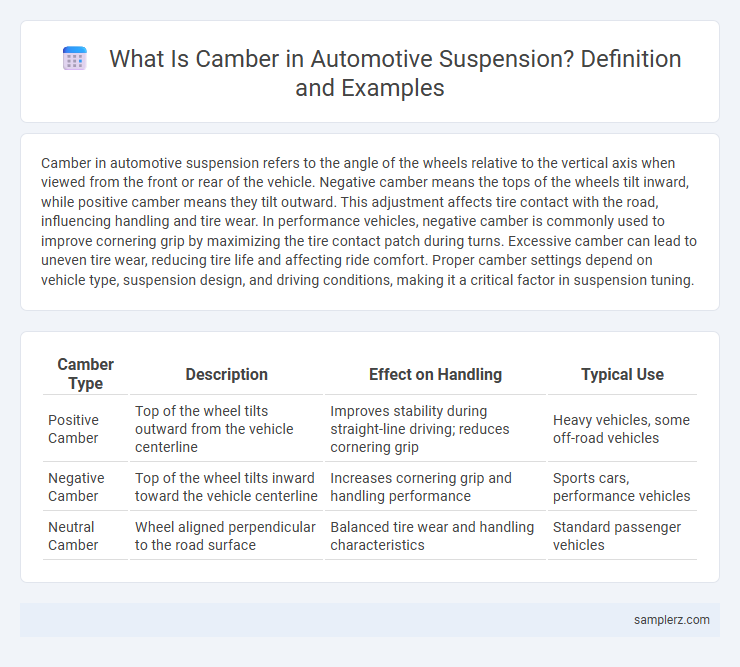Camber in automotive suspension refers to the angle of the wheels relative to the vertical axis when viewed from the front or rear of the vehicle. Negative camber means the tops of the wheels tilt inward, while positive camber means they tilt outward. This adjustment affects tire contact with the road, influencing handling and tire wear. In performance vehicles, negative camber is commonly used to improve cornering grip by maximizing the tire contact patch during turns. Excessive camber can lead to uneven tire wear, reducing tire life and affecting ride comfort. Proper camber settings depend on vehicle type, suspension design, and driving conditions, making it a critical factor in suspension tuning.
Table of Comparison
| Camber Type | Description | Effect on Handling | Typical Use |
|---|---|---|---|
| Positive Camber | Top of the wheel tilts outward from the vehicle centerline | Improves stability during straight-line driving; reduces cornering grip | Heavy vehicles, some off-road vehicles |
| Negative Camber | Top of the wheel tilts inward toward the vehicle centerline | Increases cornering grip and handling performance | Sports cars, performance vehicles |
| Neutral Camber | Wheel aligned perpendicular to the road surface | Balanced tire wear and handling characteristics | Standard passenger vehicles |
Understanding Camber in Automotive Suspension
Camber in automotive suspension refers to the angle of the wheels relative to the vertical axis when viewed from the front or rear of the vehicle. Negative camber improves cornering performance by increasing tire contact with the road, while positive camber can enhance straight-line stability. Precise camber adjustments are crucial for optimizing tire wear, handling, and overall vehicle dynamics.
Types of Camber: Positive vs. Negative
Positive camber occurs when the top of the wheels tilt outward from the vehicle's centerline, improving stability in straight-line driving and reducing tire wear on uneven terrain. Negative camber features wheels tilted inward at the top, enhancing cornering grip and handling by increasing the tire's contact patch during turns. Proper camber adjustment in automotive suspension systems optimizes tire performance, handling characteristics, and overall vehicle dynamics.
Real-World Examples of Camber Adjustments
Camber adjustments in automotive suspension are crucial for optimizing tire contact during cornering, as seen in motorsports where negative camber enhances grip on tight turns. For instance, race cars often use aggressive negative camber angles ranging from -2deg to -4deg to maximize lateral traction. Street vehicles typically maintain slight negative camber between -0.5deg and -1.5deg to balance tire wear and handling performance on everyday roads.
Camber in Performance and Racing Cars
Camber angle in performance and racing cars is crucial for maximizing tire contact during cornering, enhancing grip and stability at high speeds. Negative camber settings, typically between -1 to -3 degrees, improve lateral traction by counteracting body roll and maintaining optimal tire patch. Precise camber adjustment directly influences lap times and handling responsiveness on track conditions.
Effects of Camber on Tire Wear
Negative camber causes the tire's inner edge to bear more load, leading to accelerated wear on that side, while positive camber increases wear on the outer edge due to uneven contact with the road surface. Excessive camber angles reduce the tire's contact patch during straight-line driving, causing irregular tire tread wear and decreased tire lifespan. Proper camber adjustment optimizes tire wear patterns, improves handling stability, and maximizes tire performance in automotive suspension systems.
Camber Angle in Everyday Passenger Vehicles
The camber angle in everyday passenger vehicles typically ranges from -0.5 to -1.5 degrees to enhance tire contact with the road during cornering. Negative camber improves grip by tilting the top of the wheels inward, which reduces understeer and increases stability in turns. Properly adjusted camber angles also contribute to even tire wear and optimized handling performance in urban and highway driving conditions.
Suspension Tuning: Adjusting Camber for Handling
Adjusting camber in suspension tuning directly influences a vehicle's cornering grip and tire wear by altering the angle of the wheels relative to the road. Negative camber improves handling on turns by increasing the tire contact patch during cornering, enhancing stability and traction. Precise camber settings are crucial in performance and race cars, where optimal suspension tuning balances handling responsiveness with tire longevity.
Off-Road Vehicles and Camber Applications
Off-road vehicles utilize negative camber in suspension systems to enhance tire contact during cornering on uneven terrain, improving stability and traction. Adjustable camber settings allow for optimized wheel alignment, reducing tire wear and increasing control in rugged environments. This application is crucial for off-road performance, where maintaining grip on loose surfaces is essential.
Common Signs of Incorrect Camber
Uneven tire wear, such as excessive wear on the inner or outer edges, commonly indicates incorrect camber in a vehicle's suspension. Steering pull to one side during driving often signals that the camber angle is out of specification. Poor handling and reduced cornering performance can also result from improper camber settings affecting suspension alignment.
How to Measure and Set Camber in Your Vehicle
Camber in automotive suspension refers to the angle of the wheels relative to the vertical axis when viewed from the front or rear of the vehicle. To measure camber, use a camber gauge or an alignment machine, ensuring the vehicle is on a level surface with tires properly inflated. Adjust camber by altering the upper or lower control arms, strut mounts, or camber bolts, aiming for specifications provided by the vehicle manufacturer to optimize tire contact with the road and improve handling performance.

example of camber in suspension Infographic
 samplerz.com
samplerz.com